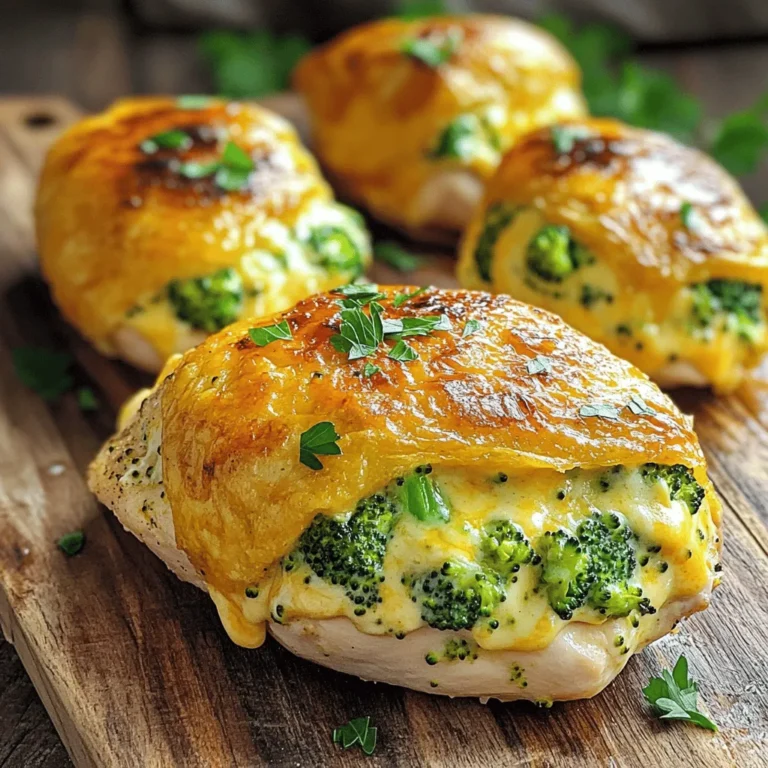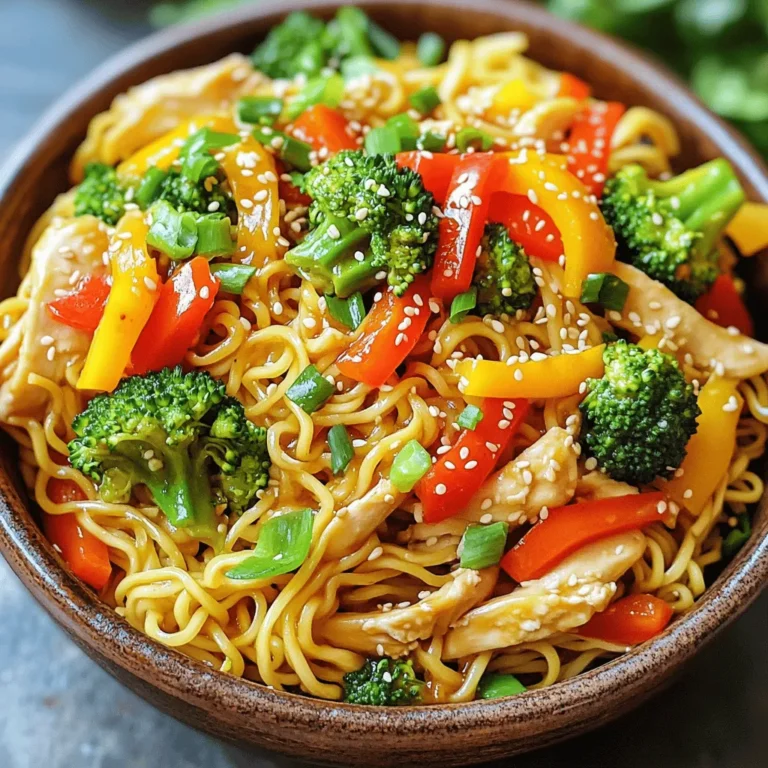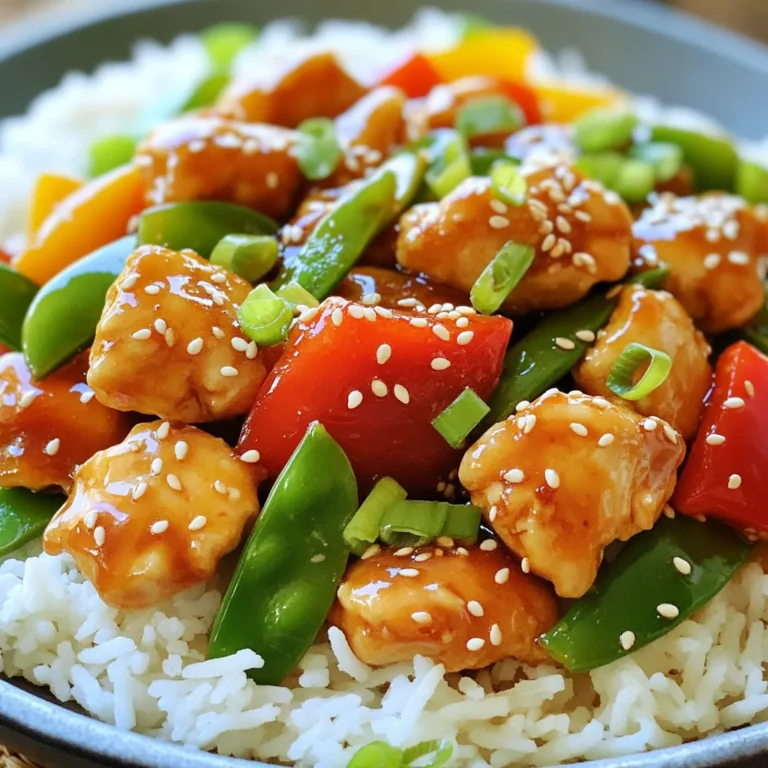Creamy Garlic Spinach Stuffed Salmon Flavorful Delight
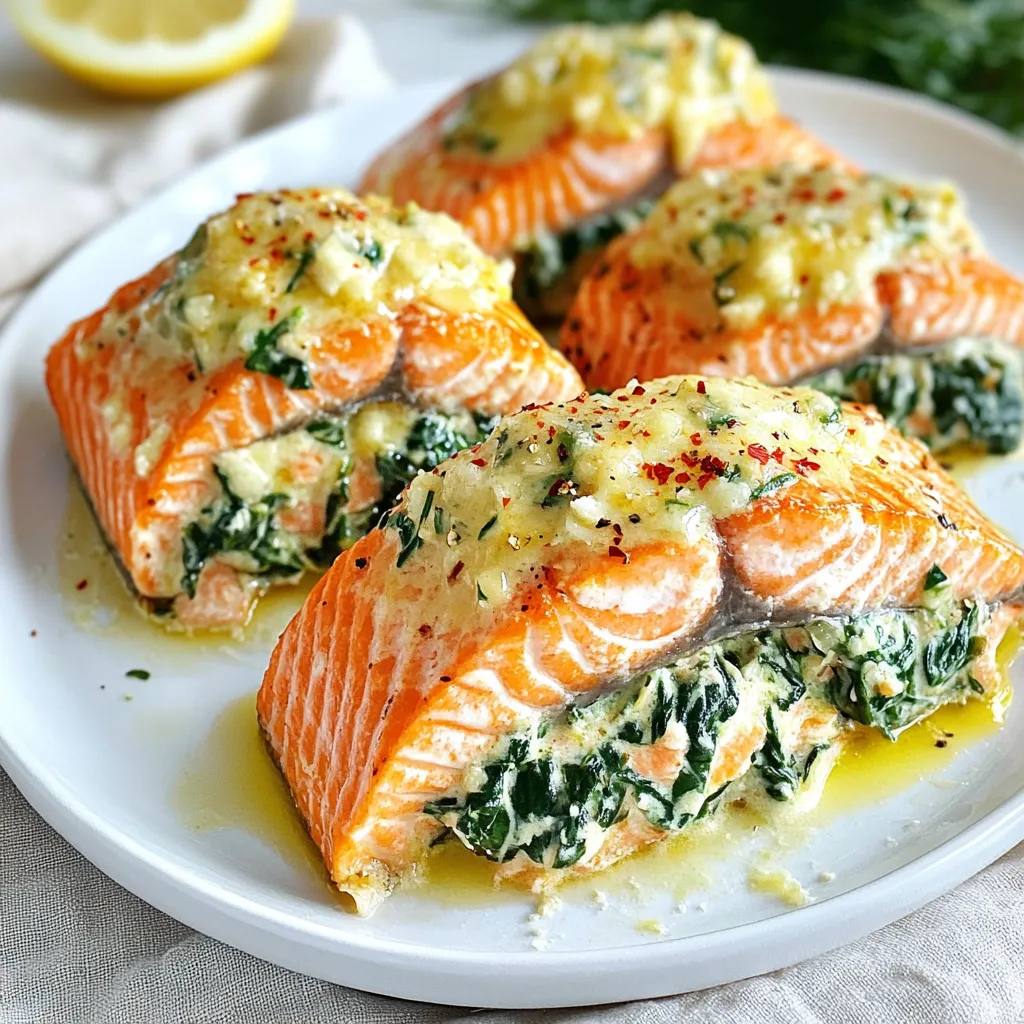
Looking for a special dish to impress your family or guests? Dive into my Creamy Garlic Spinach Stuffed Salmon, a delightful recipe that combines rich flavors and healthy ingredients. Not only is this dish easy to make, but it also looks stunning on the plate. I’ll guide you through each step, from selecting fresh salmon to perfecting the stuffing. Let’s create a meal that brings smiles to the dinner table!
Why I Love This Recipe
- Delicious Flavor Combination: The creamy garlic spinach filling pairs perfectly with the rich salmon, creating a mouthwatering dish that is both satisfying and elegant.
- Healthy and Nutritious: This recipe is packed with protein, healthy fats, and nutrient-rich spinach, making it a wholesome meal option for any day of the week.
- Quick and Easy Preparation: With a prep time of just 15 minutes, this dish is perfect for busy weeknights while still impressing family and guests.
- Versatile Serving Options: Serve it over rice, quinoa, or alongside a fresh salad for a complete meal that can easily be adapted to your preferences.
Ingredients
Main Ingredients List
– 4 salmon fillets, skinless
– 2 cups fresh spinach, chopped
– 3 cloves garlic, minced
– 1 cup cream cheese, softened
– 1/4 cup grated Parmesan cheese
– 1/2 teaspoon lemon zest
– 1 tablespoon lemon juice
– Salt and pepper to taste
– 1 tablespoon olive oil
Optional Ingredients for Added Flavor
– 1 teaspoon dried dill
– 1/4 teaspoon red pepper flakes
Equipment Needed for Preparation
– Sharp knife
– Skillet
– Baking sheet
– Parchment paper
– Medium mixing bowl
Gathering the right ingredients is key to creating the best creamy garlic spinach stuffed salmon. You will need fresh salmon fillets, spinach, and garlic. These flavors mix to create a rich, delicious filling.
For a little extra flair, consider adding dried dill or red pepper flakes. Dill gives a nice herbal note, while red pepper flakes add heat.
Make sure you have the right tools. A sharp knife helps you create pockets in the salmon. A skillet is great for sautéing the garlic and spinach. A baking sheet lined with parchment paper makes cleanup easy too.
With these ingredients and tools, you’re all set to start cooking this delightful dish!

Step-by-Step Instructions
Prepping the Oven and Ingredients
First, turn your oven to 375°F (190°C). This will ensure the salmon cooks evenly. While the oven heats, gather your ingredients. You will need four skinless salmon fillets, two cups of fresh spinach, three cloves of minced garlic, and one cup of softened cream cheese. Don’t forget the Parmesan cheese, lemon zest, lemon juice, olive oil, salt, pepper, and optional dill or red pepper flakes.
Preparing the Spinach Mixture
Next, heat a skillet over medium heat. Add one tablespoon of olive oil to the skillet. Once hot, add the minced garlic. Sauté for about one minute until you smell the garlic. Now, toss in the chopped spinach. Cook it for two to three minutes until it wilts. Remove the skillet from heat. In a medium bowl, mix the softened cream cheese, grated Parmesan, lemon zest, and lemon juice. Stir until the mixture is smooth. Add the spinach and garlic mixture. Season with salt, pepper, and optional dill or red pepper flakes.
Stuffing the Salmon Fillets
Take your salmon fillets and place them on a cutting board. Use a sharp knife to slice a pocket into each fillet. Be careful not to cut all the way through. Now, fill each pocket with the creamy spinach mixture. Make sure to stuff them generously to enjoy the flavors in every bite.
Baking Instructions
Lay the stuffed salmon fillets on a baking sheet lined with parchment paper. Bake them in the preheated oven for 15 to 20 minutes. You will know they are done when the salmon flakes easily with a fork. For a crispy top, you can broil the salmon for an extra two to three minutes at the end. This adds a nice texture and flavor.
Tips & Tricks
How to Choose Fresh Salmon
When choosing fresh salmon, look for bright, shiny skin. The fish should smell like the ocean, not fishy. Press gently on the flesh; it should spring back. If it leaves an indent, it is not fresh. Check for clear eyes, which signal freshness. Always choose wild-caught salmon when possible for the best flavor.
Cooking Tips for Perfectly Stuffed Salmon
To make your stuffed salmon perfect, use a sharp knife. Carefully slice a pocket in each fillet. Don’t cut all the way through; you want it to hold the stuffing. Make the stuffing creamy and flavorful. Mix in salt and pepper to taste. Bake until the salmon flakes easily with a fork. If you like a crispy top, broil for a few minutes at the end.
Presentation Ideas for Serving
For a lovely presentation, place the stuffed salmon on a bed of rice or quinoa. This adds color and texture. Use fresh herbs like parsley or dill for garnish. A few lemon wedges on the side brighten the plate. This simple touch makes the dish look fancy and inviting. Serving it this way impresses your guests and family.
Pro Tips
- Fresh Spinach Matters: Always use fresh spinach for a vibrant flavor and better texture. Avoid frozen spinach as it can make the filling watery.
- Perfectly Cooked Salmon: To ensure your salmon is cooked evenly, let it come to room temperature for about 15-20 minutes before baking.
- Customize Your Filling: Feel free to add other ingredients like sun-dried tomatoes, artichokes, or feta cheese to the filling for a unique flavor twist.
- Check for Doneness: Use a fork to gently flake the thickest part of the salmon; if it flakes easily and is opaque, it’s ready to serve!

Variations
Adding Different Cheeses or Herbs
You can change the cheese in this dish. Try mozzarella for a gooey texture. Feta gives a salty taste. Add goat cheese for creaminess and tang. Herbs can also change the flavor. Fresh basil or parsley adds brightness. Thyme or oregano brings warmth. Use what you love to make it yours.
Using Other Protein Sources
Salmon is great, but other fish work too. Try stuffed trout or tilapia. If you prefer meat, chicken breast is a good choice. Just ensure to pound them thin. You can even use portobello mushrooms for a tasty vegetarian option. Each protein adds its own twist.
Alternative Cooking Methods (Grilling, Pan-Searing)
You can grill your stuffed salmon for a smoky flavor. Just wrap it in foil to keep it moist. Pan-searing is another option. Heat oil in a pan, then cook the salmon on medium heat. Both methods give a nice crust while keeping the filling creamy.
Storage Info
How to Store Leftover Stuffed Salmon
To keep your leftover stuffed salmon fresh, place it in an airtight container. Make sure to let it cool down first. I usually store it in the fridge. It can last for about 2-3 days. If you want to keep it longer, freezing is a great option.
Reheating Tips for Best Results
When you’re ready to eat the leftover salmon, preheat your oven to 350°F (175°C). Place the salmon on a baking sheet. Cover it with foil to keep it moist. Heat it for about 10-15 minutes. You can also reheat it in the microwave for about 1-2 minutes, but it may dry out a bit.
Freezing Instructions for Long-Term Storage
To freeze stuffed salmon, wrap each piece tightly in plastic wrap. Then, place them in a freezer bag or container. Be sure to remove as much air as possible. Label the bag with the date. The salmon can be frozen for up to 2-3 months. To thaw, place it in the fridge overnight before reheating.
FAQs
What can I substitute for cream cheese?
You can use Greek yogurt or ricotta cheese. Both options offer a creamy texture. They will change the taste slightly, but they work well. If you want a vegan choice, try cashew cream. This is made by blending soaked cashews with a bit of lemon juice. It adds creaminess without dairy.
How do I know when the salmon is done?
The best way to check is by using a fork. Gently flake the fish at the thickest part. If it flakes easily and is opaque, it’s ready. You can also use a meat thermometer. The internal temperature should reach 145°F (63°C). This ensures it is safe and tasty.
Can I make this recipe in advance?
Yes, you can prepare it ahead of time. Stuff the salmon fillets and place them in the fridge. Cover them tightly for up to 24 hours. When ready to cook, just bake them. This makes dinner easy and quick.
Is there a dairy-free option for this recipe?
Absolutely! You can use dairy-free cream cheese. Many brands offer great options. You can also make your own nut-based cream cheese. Blend soaked cashews with lemon juice, garlic, and salt. This gives you a creamy filling that is dairy-free and delicious.
You learned about making stuffed salmon, starting with key ingredients and tools. I shared step-by-step guides for preparation and cooking. You discovered tips for choosing fresh salmon and creative serving ideas. Variations allowed for personal touches, while storage tips ensure freshness. Remember, experimenting with flavors can make it fun. Use these insights to make delicious stuffed salmon at home. You’ll impress friends and family with your cooking skill
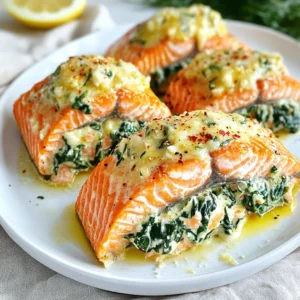
Creamy Garlic Spinach Stuffed Salmon
Ingredients
- 4 fillets salmon, skinless
- 2 cups fresh spinach, chopped
- 3 cloves garlic, minced
- 1 cup cream cheese, softened
- 1 4 cup grated Parmesan cheese
- 1 2 teaspoon lemon zest
- 1 tablespoon lemon juice
- to taste salt and pepper
- 1 tablespoon olive oil
- 1 teaspoon dried dill (optional)
- 1 4 teaspoon red pepper flakes (optional for a kick)
Instructions
- Preheat your oven to 375°F (190°C).
- In a skillet over medium heat, add olive oil and sauté the minced garlic until fragrant, about 1 minute.
- Add the chopped spinach to the skillet and cook until wilted, about 2-3 minutes. Remove from heat.
- In a medium bowl, combine the softened cream cheese, grated Parmesan cheese, lemon zest, and lemon juice. Mix until smooth.
- Stir in the sautéed spinach and garlic mixture. Season with salt, pepper, and optional dill or red pepper flakes to taste.
- Using a sharp knife, create a pocket in each salmon fillet by slicing horizontally, being careful not to cut all the way through.
- Stuff each salmon fillet generously with the creamy spinach mixture.
- Place the stuffed salmon fillets on a baking sheet lined with parchment paper.
- Bake in the preheated oven for 15-20 minutes, or until the salmon is cooked through and flakes easily with a fork.
- Optional: Broil the salmon for an additional 2-3 minutes at the end for a slightly crispy top.

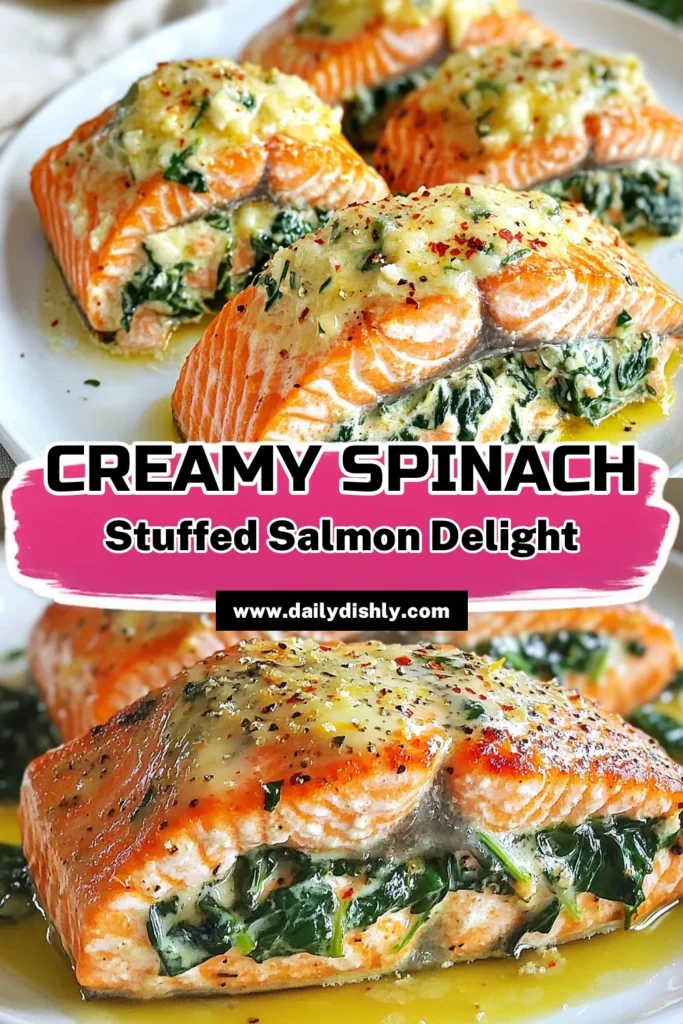
![- 2 boneless, skinless chicken breasts, diced - 2 cups broccoli florets For this dish, I love using fresh chicken and broccoli. The chicken gives a nice, juicy bite. The broccoli adds color and crunch. You can cut the chicken into small pieces. This helps it cook evenly and quickly. For the broccoli, I recommend using florets. They will cook just right and look great on your plate. - 8 ounces fettuccine or pasta of choice - 1 tablespoon olive oil - 3 cloves garlic, minced - 1 cup heavy cream - 1 cup grated Parmesan cheese For the pasta, fettuccine works best. It holds the sauce well. You can use any pasta you like. Just remember to cook it al dente. Olive oil keeps the chicken moist. Garlic adds amazing flavor to the dish. Heavy cream and Parmesan cheese create a rich, creamy sauce. Together, they make this meal feel special. - Salt and pepper to taste - 1/2 teaspoon dried Italian herbs - Fresh parsley, chopped (for garnish) Seasoning is key to great flavor. Use salt and pepper to taste. Italian herbs add warmth and depth. I like to finish the dish with fresh parsley for color. It brightens the plate and makes it look fresh. These simple ingredients elevate the dish without being overwhelming. For the full recipe, check out the details above! First, heat 1 tablespoon of olive oil in a large skillet over medium heat. While the oil heats, dice 2 boneless, skinless chicken breasts. Once the oil is hot, add the chicken to the skillet. Season it with salt, pepper, and 1/2 teaspoon of dried Italian herbs. Cook the chicken for about 5 to 7 minutes. Stir it occasionally to brown all sides. When it’s done, it should be golden and cooked through. Remove the chicken from the skillet and set it aside for now. In the same skillet, add 3 cloves of minced garlic. Sauté the garlic for about 1 minute until it smells good. Then, add 2 cups of broccoli florets to the skillet. Stir and cook for 3 to 4 minutes. You want the broccoli to be tender but still bright green. This will keep it crisp and flavorful. Next, cook 8 ounces of fettuccine or your favorite pasta in a separate pot. Follow the package instructions and drain it once it's al dente. Now, back in the skillet with the broccoli, pour in 1 cup of heavy cream. Bring it to a gentle simmer. Stir in 1 cup of grated Parmesan cheese. Keep stirring until the cheese melts and the sauce is smooth. Add the chicken and drained pasta back into the skillet. Toss everything together so it’s coated in the creamy sauce. Let it heat through for 2 to 3 minutes. Adjust the taste with more salt or pepper if needed. Serve hot, and don’t forget to garnish with fresh parsley! For the full recipe, check out the [Full Recipe]. To get juicy chicken, start with diced pieces. This helps them cook evenly. Cook the chicken until it is a nice golden brown. This usually takes about 5 to 7 minutes. Make sure to not overcrowd the skillet. This allows each piece to sear well. After cooking, let the chicken rest for a few minutes. This keeps the juices inside. Broccoli should stay bright green and crisp. Add it to the skillet after the garlic. Sauté for just 3 to 4 minutes. You want it tender but still crunchy. If you cook it too long, it will turn dull. To keep that vibrant color, you can also shock it in cold water after cooking. This method locks in color and nutrition. The sauce should be creamy and smooth. If it’s too thick, add a little pasta water. This water has starch from cooking the pasta. It helps make the sauce silkier. If it’s too thin, let it simmer a bit longer. Stir in more cheese if you want it richer. Taste as you go to get the perfect balance. For the full recipe, check the details above. {{image_2}} You can swap out chicken for other meats. Shrimp works well and cooks quickly. You can also use turkey or even tofu for a vegetarian twist. Each protein adds its unique flavor. Just adjust cooking times to ensure your choice is fully cooked. Broccoli is excellent, but you can mix in other veggies. Bell peppers add sweetness and crunch. Zucchini or spinach also fit well in this dish. Feel free to experiment! Each vegetable brings a new taste and color. Just make sure to adjust cooking time based on what you use. If you need a gluten-free meal, choose gluten-free pasta. Many brands offer great options that taste good. You can also skip pasta and use rice instead. This keeps the dish hearty while meeting dietary needs. Always check labels to ensure your ingredients are gluten-free. For the full recipe, check the section above. You can store leftovers in the fridge. Place the Chicken and Broccoli Alfredo in an airtight container. It stays fresh for up to three days. Make sure to let it cool down before you seal it. This helps keep the flavor and texture. If you want to save some for later, freezing works well. Use a freezer-safe container or bag. Leave some space for expansion. You can freeze it for up to two months. When you're ready to eat, thaw it in the fridge overnight. To reheat, use the stovetop or microwave. If using the stovetop, add a splash of cream or water. This keeps the dish moist. Stir it often over low heat until warm. If using a microwave, cover the dish to trap steam. Heat in short bursts and stir in between. This way, you'll enjoy a creamy meal again! Yes, you can use frozen broccoli. Just add it to the skillet while cooking the garlic. Frozen broccoli may need a few extra minutes to cook. Make sure it is heated through and tender before serving. This option saves time and works well in this dish. Fettuccine is the best choice for this recipe. It holds the creamy sauce well. However, you can use other pasta types too. Penne, rotini, or even whole wheat pasta are great options. Choose what you like or have at home for this meal. To make this dish healthier, consider these tips: - Use whole-grain pasta for more fiber. - Swap heavy cream for low-fat milk or a plant-based cream. - Add more vegetables like bell peppers or spinach for extra nutrients. - Use less cheese or a lighter cheese option to cut calories. These changes can keep the dish tasty while boosting its nutrition. Check out the Full Recipe for even more ideas! This blog post covered how to make Chicken and Broccoli Alfredo. We explored key ingredients, like chicken, pasta, and sauce. I shared step-by-step instructions for cooking and sautéing. You learned tips for perfect chicken and bright broccoli. We also talked about variations, like swapping proteins or veggies. Lastly, I provided storage info to keep leftovers fresh. Try this recipe to impress. Remember, cooking is fun and easy!](https://dailydishly.com/wp-content/uploads/2025/06/4029d33c-44d0-458a-b053-e8bf24c75967-768x768.webp)
